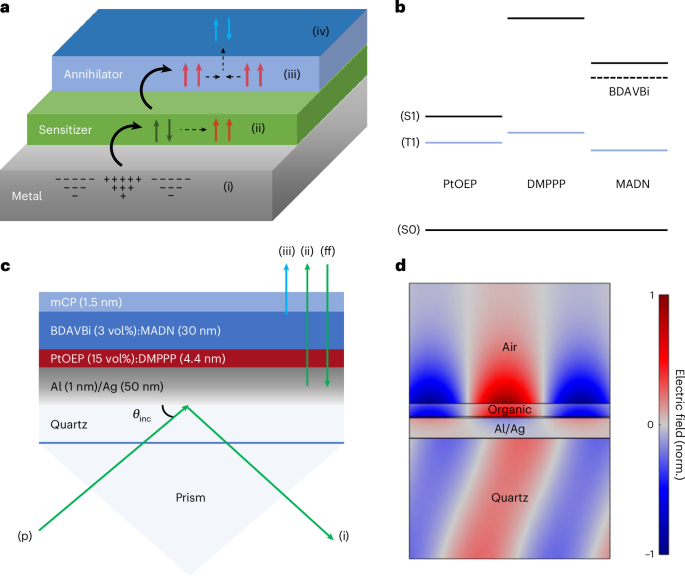Nadort, A., Zhao, J. & Goldys, E. M. Lanthanide upconversion luminescence at the nanoscale: fundamentals and optical properties. Nanoscale 8, 13099–13130 (2016).
Lin, Y. L. et al. Enhanced sub-bandgap efficiency of a solid-state organic intermediate band solar cell using triplet–triplet annihilation. Energy Environ. Sci. 10, 1465–1475 (2017).
Sheng, W. et al. Tremendously enhanced photocurrent enabled by triplet–triplet annihilation up-conversion for high-performance perovskite solar cells. Energy Environ. Sci. 14, 3532–3541 (2021).
Li, C. et al. Photocurrent enhancement from solid-state triplet–triplet annihilation upconversion of low-intensity, low-energy photons. ACS Photonics 3, 784–790 (2016).
Beery, D., Wheeler, J. P., Arcidiacono, A. & Hanson, K. CdSe quantum dot sensitized molecular photon upconversion solar cells. ACS Appl. Energy Mater. 3, 29–37 (2020).
Ravetz, B. D. et al. Photoredox catalysis using infrared light via triplet fusion upconversion. Nature 565, 343–346 (2019).
Zhu, X., Su, Q., Feng, W. & Li, F. Anti-Stokes shift luminescent materials for bio-applications. Chem. Soc. Rev. 46, 1025–1039 (2017).
Sanders, S. N. et al. Triplet fusion upconversion nanocapsules for volumetric 3D printing. Nature 604, 474–478 (2022).
Gray, V., Moth-Poulsen, K., Albinsson, B. & Abrahamsson, M. Towards efficient solid-state triplet–triplet annihilation based photon upconversion: supramolecular, macromolecular and self-assembled systems. Coord. Chem. Rev. 362, 54–71 (2018).
Alves, J., Feng, J., Nienhaus, L. & Schmidt, T. W. Challenges, progress and prospects in solid state triplet fusion upconversion. J. Mater. Chem. C 10, 7783–7798 (2022).
Lin, T.-A., Perkinson, C. F. & Baldo, M. A. Strategies for high-performance solid-state triplet–triplet-annihilation-based photon upconversion. Adv. Mater. 32, 1908175 (2020).
Ogawa, T. et al. Donor–acceptor–collector ternary crystalline films for efficient solid-state photon upconversion. J. Am. Chem. Soc. 140, 8788–8796 (2018).
Wu, M. et al. Solid-state infrared-to-visible upconversion sensitized by colloidal nanocrystals. Nat. Photon. 10, 31–34 (2016).
Wu, T. C., Congreve, D. N. & Baldo, M. A. Solid state photon upconversion utilizing thermally activated delayed fluorescence molecules as triplet sensitizer. Appl. Phys. Lett. 107, 031103 (2015).
Izawa, S. & Hiramoto, M. Efficient solid-state photon upconversion enabled by triplet formation at an organic semiconductor interface. Nat. Photon. 15, 895–900 (2021).
Hu, M. et al. Bulk heterojunction upconversion thin films fabricated via one-step solution deposition. ACS Nano 17, 22642–22655 (2023).
Wu, D. M., García-Etxarri, A., Salleo, A. & Dionne, J. A. Plasmon-enhanced upconversion. J. Phys. Chem. Lett. 5, 4020–4031 (2014).
Honda, J., Sugawa, K., Tahara, H. & Otsuki, J. Plasmonic metal nanostructures meet triplet–triplet annihilation-based photon upconversion systems: performance improvements and application trends. Nanomaterials 13, 1559 (2023).
Bangle, R. E., Li, H. & Mikkelsen, M. H. Uncovering the mechanisms of triplet–triplet annihilation upconversion enhancement via plasmonic nanocavity tuning. ACS Nano 17, 24022–24032 (2023).
Bujak, Ł, Narushima, K., Sharma, D. K., Hirata, S. & Vacha, M. Plasmon enhancement of triplet exciton diffusion revealed by nanoscale imaging of photochemical fluorescence upconversion. J. Phys. Chem. C 121, 25479–25486 (2017).
Baluschev, S. et al. Metal-enhanced up-conversion fluorescence: effective triplet−triplet annihilation near silver surface. Nano Lett. 5, 2482–2484 (2005).
Park, J. K. et al. Enhanced triplet–triplet annihilation in bicomponent organic systems by using a gap plasmon resonator. Nanoscale 7, 12828–12832 (2015).
Poorkazem, K., Hesketh, A. V. & Kelly, T. L. Plasmon-enhanced triplet–triplet annihilation using silver nanoplates. J. Phys. Chem. C 118, 6398–6404 (2014).
Wisch, J. A. et al. Plasmon mediated near-field energy transfer from solid-state, electrically injected excitons to solution phase chromophores. Adv. Funct. Mater. 33, 2214367 (2023).
An, K. H., Shtein, M. & Pipe, K. P. Surface plasmon mediated energy transfer of electrically-pumped excitons. Opt. Express 18, 4041–4048 (2010).
Andrew, P. & Barnes, W. L. Energy transfer across a metal film mediated by surface plasmon polaritons. Science 306, 1002–1005 (2004).
Chen, Y., Chen, J., Zhao, Y. & Ma, D. High efficiency blue phosphorescent organic light-emitting diode based on blend of hole- and electron-transporting materials as a co-host. Appl. Phys. Lett. 100, 213301 (2012).
Baldo, M. A., Lamansky, S., Burrows, P. E., Thompson, M. E. & Forrest, S. R. Very high-efficiency green organic light-emitting devices based on electrophosphorescence. Appl. Phys. Lett. 75, 4–6 (1999).
Sambles, J. R., Bradbery, G. W. & Yang, F. Optical excitation of surface plasmons: an introduction. Contemp. Phys. 32, 173–183 (1991).
Giebink, N. C. et al. Intrinsic luminance loss in phosphorescent small-molecule organic light emitting devices due to bimolecular annihilation reactions. J. Appl. Phys. 103, 044509 (2008).
Giebink, N. C., D’Andrade, B. W., Weaver, M. S., Brown, J. J. & Forrest, S. R. Direct evidence for degradation of polaron excited states in organic light emitting diodes. J. Appl. Phys. 105, 124514 (2009).
Fusella, M. A. et al. Plasmonic enhancement of stability and brightness in organic light-emitting devices. Nature 585, 379–382 (2020).
Fusella, M. et al. Optimizing plasmonic PHOLEDs for efficiency, stability, and angular profile. In Proc. International Display Workshops 544 (IDW, 2023).
Zhao, H., Arneson, C. E., Fan, D. & Forrest, S. R. Stable blue phosphorescent organic LEDs that use polariton-enhanced Purcell effects. Nature 626, 300–305 (2024).
Aldrich, M. pspectro: photometric and colorimetric calculations (MATLAB, 2025); https://www.mathworks.com/matlabcentral/fileexchange/28185-pspectro-photometric-and-colorimetric-calculations

